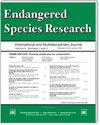美国上东湾沿岸平原红冠啄木鸟栖息地特征与部分幼鸟损失的关系
IF 2.9
2区 环境科学与生态学
Q2 BIODIVERSITY CONSERVATION
引用次数: 0
摘要
一些红冠啄木鸟(RCW)的种群仍未得到充分研究。这是值得注意的,因为纳入人口统计和地点特征的管理可能有利于RCW的恢复。塔拉迪加国家森林(美国阿拉巴马州)的奥克穆尔吉护林员区(Oakmulgee Ranger District)没有铁蒺藜(Aristida stricta),林分面积小,地形起伏,并且包含一个未充分研究的RCW种群。我们在Oakmulgee的目标是描述RCW栖息地的特征,可能确定栖息地与其他地区不同的方式,并估计栖息地与生殖产量之间的关系。结果表明,70.2%和92.5%的样本林分符合美国鱼类和野生动物管理局(USFWS) RCW恢复计划中规定的大小松林基面积(BA)恢复标准阈值。长叶松占74.6%的林分满足阔叶松冠层组成的阈值,而火炬松占60.0%的林分不满足阔叶松冠层组成的阈值。很少有林分达到草本下层植被推荐比例(19.8%)或硬木中层推荐缺失率。大松(胸高直径≥25.4 cm;小松(≥10和<25.4 cm DBH)面积较小,休眠季节燃烧面积较大,RCW密度较高。在我们的模型中,阔叶树的上层和中层不影响卵或幼雏的产量。正如USFWS RCW恢复计划所指出的那样,奥克穆尔吉的硬木可能会导致不利的栖息地,并且与RCW范围内栖息地的变化有关。RCW范围内的区域研究不足,有限的人员和资金阻碍了了解和保护的进展。本文章由计算机程序翻译,如有差异,请以英文原文为准。
Red-cockaded woodpecker habitat characteristics associated with partial brood loss in the Upper East Gulf Coastal Plain, USA
Some red-cockaded woodpecker (RCW) Dryobates borealis populations remain understudied. This is notable because management that incorporates population demographics and site characteristics may benefit RCW recovery. The Oakmulgee Ranger District of the Talladega National Forest (Alabama, USA) has no wiregrass Aristida stricta, small forest stand sizes, rolling topography, and contains an understudied RCW population. Our goal in the Oakmulgee was to characterize RCW habitat, possibly identify ways in which habitat differed from other regions, and estimate associations between habitat and reproductive output. We found that 70.2 and 92.5% of sampled stands met recovery standard thresholds for small and large pine basal area (BA) as defined in the United States Fish and Wildlife Service (USFWS) RCW Recovery Plan. While 74.6% of longleaf pine Pinus palustris-dominated stands met the threshold for overstory hardwood canopy composition, 60.0% of loblolly pine P. taeda-dominated stands did not. Few stands met the recommended percentage of herbaceous understory (19.8%) or recommended absence of hardwood midstory. A lower rate of partial brood loss was associated with a greater area of large pines (≥25.4 cm diameter at breast height; DBH), a smaller area of small pines (≥10 and <25.4 cm DBH), a larger area burned in the dormant season, and higher RCW density. In our models, hardwood overstory and midstory did not influence egg or hatchling production. Hardwoods in the Oakmulgee could contribute to unfavorable habitat, as indicated in the USFWS RCW Recovery Plan, as well as relate to variation in habitat across the RCW’s range. Regions of the RCW’s range are understudied, and limited staffing and funding impede advances in understanding and conservation.
求助全文
通过发布文献求助,成功后即可免费获取论文全文。
去求助
来源期刊

Endangered Species Research
BIODIVERSITY CONSERVATION-
CiteScore
5.50
自引率
6.50%
发文量
38
审稿时长
31 weeks
期刊介绍:
ESR is international and interdisciplinary. It covers all endangered forms of life on Earth, the threats faced by species and their habitats and the necessary steps that must be undertaken to ensure their conservation. ESR publishes high quality contributions reporting research on all species (and habitats) of conservation concern, whether they be classified as Near Threatened or Threatened (Endangered or Vulnerable) by the International Union for the Conservation of Nature and Natural Resources (IUCN) or highlighted as part of national or regional conservation strategies. Submissions on all aspects of conservation science are welcome.
 求助内容:
求助内容: 应助结果提醒方式:
应助结果提醒方式:


